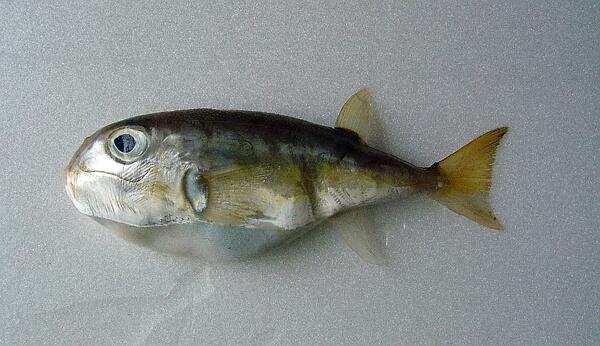The Food and Drug Administration (FDA) on Wednesday identified the lunartail puffer fish as the species responsible for killing one and sickening eight in Nantou County last month, which is toxic enough to kill a diner who eats only two pieces of sashimi.
Through DNA analysis of the fish that poisoned nine diners on Nov. 25, the agency identified the species as a lunartail, or Lagocephalus lunaris, FDA Research and Analysis division chief Wang Der-yuan (王德原) told a news conference.
A sample taken from the sashimi served had 134.4mg per kilogram of tetrodotoxin (TTX), a defensive neurotoxin found in many types of puffer fish, Wang said.

Photo: Chiu Chih-jou, Taipei Times
Samples from the cooked fish and soup showed TTX levels of 33.48mg per kilogram and 31.86mg per kilogram respectively, he said.
The internal organs and skin of the fish presented the most TTX, but further analysis is necessary to quantify the precise levels, he added.
TTX is highly toxic, with consumption of only 0.2mg leading to poisoning symptoms and 1mg to 2mg potentially fatal, Wang said.

Photo courtesy of the Academia Sinica Fish Database of Taiwan
Based on the FDA’s findings, each 10mg piece of sashimi contained about 1.34mg of TTX, meaning that eating two could be fatal, he said.
The lunartail puffer fish is common in the waters around Taiwan, National Taiwan Ocean University Department of Food Science associate professor Chen Tai-yuan (陳泰源) said.
Its plump appearance makes it attractive to many seafood enthusiasts, but its viscera and skin contain particularly high levels of TTX, which cannot be removed through cooking, he said.
Four cases of puffer fish poisoning have been recorded in Taiwan over the past decade, sickening 17 and killing one, FDA Deputy Director Lin Chin-fu (林金富) said.
Japan saw 180 cases from 2013 to last year, sickening 246 and killing five, despite it having a licensing system in place for the sale of puffer fish, he said.
Due to the high risk, the FDA does not have a licensing system and does not plan to instate one, he added.
Under the Act Governing Food Safety and Sanitation (食品安全衛生管理法), food or food additives that contain toxins are not allowed to be produced, processed, stored, sold or given as gifts, so the FDA discourages the sale and consumption of puffer fish, Lin said.
Restaurants that serve puffer fish resulting in food poisoning face a fine of NT$60,000 to NT$200 million (US$1,905 to US$6.35 million), and if the case is serious, the restaurant could be ordered to shut down and the manager could face a prison sentence of up to seven years, he said.

Three batches of banana sauce imported from the Philippines were intercepted at the border after they were found to contain the banned industrial dye Orange G, the Food and Drug Administration (FDA) said yesterday. From today through Sept. 2 next year, all seasoning sauces from the Philippines are to be subject to the FDA’s strictest border inspection, meaning 100 percent testing for illegal dyes before entry is allowed, it said in a statement. Orange G is an industrial coloring agent that is not permitted for food use in Taiwan or internationally, said Cheng Wei-chih (鄭維智), head of the FDA’s Northern Center for

LOOKING NORTH: The base would enhance the military’s awareness of activities in the Bashi Channel, which China Coast Guard ships have been frequenting, an expert said The Philippine Navy on Thursday last week inaugurated a forward operating base in the country’s northern most province of Batanes, which at 185km from Taiwan would be strategically important in a military conflict in the Taiwan Strait. The Philippine Daily Inquirer quoted Northern Luzon Command Commander Lieutenant General Fernyl Buca as saying that the base in Mahatao would bolster the country’s northern defenses and response capabilities. The base is also a response to the “irregular presence this month of armed” of China Coast Guard vessels frequenting the Bashi Channel in the Luzon Strait just south of Taiwan, the paper reported, citing a

The Chinese military has built landing bridge ships designed to expand its amphibious options for a potential assault on Taiwan, but their combat effectiveness is limited due to their high vulnerability, a defense expert said in an analysis published on Monday. Shen Ming-shih (沈明室), a research fellow at the Institute for National Defense and Security Research, said that the deployment of such vessels as part of the Chinese People’s Liberation Army (PLA) Navy’s East Sea Fleet signals a strong focus on Taiwan. However, the ships are highly vulnerable to precision strikes, which means they could be destroyed before they achieve their intended

UNDER PRESSURE: The report cited numerous events that have happened this year to show increased coercion from China, such as military drills and legal threats The Chinese Communist Party (CCP) aims to reinforce its “one China” principle and the idea that Taiwan belongs to the People’s Republic of China by hosting celebratory events this year for the 80th anniversary of the end of World War II, the “retrocession” of Taiwan and the establishment of the UN, the Mainland Affairs Council (MAC) said in its latest report to the Legislative Yuan. Taking advantage of the significant anniversaries, Chinese officials are attempting to assert China’s sovereignty over Taiwan through interviews with international news media and cross-strait exchange events, the report said. Beijing intends to reinforce its “one China” principle